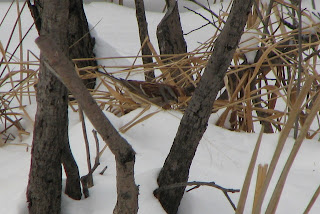He's gone 2000 miles
It's very far
The snow is falling down
Gets colder day by day
I miss you
That's the stanza that kept ringing in the back of my head last Saturday. As many birding blogs will attest, the holiday season means more to birders than time off work and school, giving and receiving, and spending time with extended family. Whether they admit or not, Christmas Bird Counts are the reason for the season! Like every year I was out participating in the Corning (NY) CBC, counting all the birds I could identify (and six individuals I didn't) in the 24-hour period that fell into what we call "the 15th of December."
This year I tried to drive less and walk more, though I didn't quite make 2,000 miles. It is certainly getting colder day by day, and I did miss some species I was hoping for. It did not snow while I was out, but we had enough from a storm earlier in the week to make it a winter wonderland.
 A stretch of woodland at Spencer Crest Nature Center, one of
A stretch of woodland at Spencer Crest Nature Center, one ofthe few accessible areas where you can walk through
the woods without getting shot at.
I was assigned my "usual" area, known simply as "Area 4." I've come to liken this to the UFO-famed "Area 51" since I'm sure there's good stuff in there, but I sure has heck can't find it. As I do every year, I went to bed with visions of redpolls, grosbeaks, and owls in my head. And, as I do every year, I dip on all of them. The fact I'm no longer a hardcore birder plays a huge role: I don't really have time to scout the area properly, I get to my area about sunrise without trolling around in the pre-dawn for hours calling for owls, like I should, and I only stay until mid-afternoon (other obligations keep me from staying until the last milliseconds of the day, straining to pick up that last missing bird). But those hours in the field are filled with focused birding, and it's exhilarating. Or maybe it was the 16 degrees (F) the car thermometer was displaying?
 A Red-bellied Woodpecker (Melanerpes carolinus)
A Red-bellied Woodpecker (Melanerpes carolinus)plays hide-and-seek at Spencer Crest. I think this is the
first one I've recorded in my Corning CBC area.
My area includes Spencer Crest Nature Center, some 225+ acres of publicly-accessible mixed forest, old field, frozen ponds, and my former stamping grounds when we first moved to the region. I used to be up there for hours every weekend, occasionally squeezing in some visits before work on weekday mornings. Since we moved it's a bit out of the way, and I prefer to focus on our own land, so now I'm only there a couple of times a year. But it's still a great place to wander for a couple of hours. And in my area, it's one of the only non-privately own pieces of land where I can walk with a pretty good chance of not getting shot at.
 A mystery bird! Well, not really - I heard this one and his buddies
A mystery bird! Well, not really - I heard this one and his buddieslong before I saw them. They were flitty little buggers, very hard
to keep in my lens! Try to ID it before scrolling down . . . .
 Not a better shot, but at least it shows a clear field mark:
Not a better shot, but at least it shows a clear field mark:a golden crown. Yep, the tiny Golden-crowned
Kinglet (Regulus satrapa). I managed to get the hemlock
branches in the back in pretty crisp focus.
Censusing the rest of the area is a lot of driving side roads, parking here and there to record what's observable while walking along the road. That includes staring at feeders outside houses that range from palatial to falling-down trailers. I didn't find any redpolls, siskins, Red-breasted Nuthatches, Purple Finches, Evening Grosbeaks, or crossbills anywhere - not visiting a feeder, not in the extensive wooded-but-private-and-heavily-posted areas, not flying over as I walked the roads. In one relatively open area comprised of an old field that rolled down a hill to a small marsh, I found an honorary "winter finch": a Northern Shrike (Lanius excubitor).
 A Northern Shrike perched some 200 meters into another
A Northern Shrike perched some 200 meters into anotherheavily-posted field. I had about a minute before it flew off, which
was about a minute longer than I should have exposed my naked
shutter- tripping fingers to the elements.
I stopped to photograph it, which I did, badly, when the door flooded open with a series of other decent sightings. A brief photography stop turned into a thirty-minute listing frenzy, but not of the open-field species like Snow Buntings, Horned Larks, and perhaps a Lapland Longspur that I was hoping for.
 While photographing the shrike I heard the unmistakable sweet
While photographing the shrike I heard the unmistakable sweetchortle of an Eastern Bluebird (Sialia sialis). Walking a bit farther I found
leafless tree, but not bare branches. There are at least four species mixed
in that flock: Northern Flicker (Colaptes auratus), American Robin
(Turdus migratorius), House Finch (Carpodacus mexicanus), and bluebirds.
 There was quite a bit of action below the species that stayed in the trees,
There was quite a bit of action below the species that stayed in the trees,mostly American Tree Sparrow (Spizella arborea). I did find two
Swamp Sparrows (Melospiza georgiana), a high count for me on a CBC.
I have to admit, I was relieved when the 22 bluebirds flushed from the spruces. My fingers were numb, even a stage past numb. And I had a lot more territory to cover, but none of the later stops would be as productive.
At a stop at the Tioga River I added both Hooded (Lophodytes cucullatus) and Common Mergansers (Mergus merganser), but failed to find the Bald Eagle that patrols along this stretch. I've never actually counted an eagle on the CBC, but every year others report sightings throughout the winter.
All in all, it was a great time, even though I didn't adequately cover my entire area. I didn't spend enough time counting all the House Sparrows (Passer domesticus), European Starlings (Sturnus vulgarus), and Rock Pigeons (Columba livia) along Market Street. I would have liked to spend more time along the Tioga River, but access in my area is pretty much non-existent. There were a couple of additional roads I didn't traverse that might have been productive, but with time constraints they just didn't happen. So many post-counting regrets!
Perhaps the only expected bird that I missed was Red-breasted Nuthatch. Maybe not a surprise, most of them headed south this year. Happily, my fingers eventually regained feeling, at the end of the day I totaled about 32 species in my area, and I was left with songs celebrating the season ringing in my ears.
Outside under the purple sky
Diamonds in the snow sparkle
Our hearts were singing
It felt like Christmas time
Information about all birds in this post can be found at All About Birds | Bird Guide
Post title credit: 2000 Miles (1983), The Pretenders.
All images © Mike Powers.









2 comments:
This year I have tried to remember it's not a competition. I think you are taking the right attitude. I'm doing 4 CBC's this year. I did scout out one morning the one I'm doing this Saturday as I had never even been there before and wanted some idea where I was going. I will problably only do some Owling for one of the four. Sounds like you had a nice time on your CBC, which I think is a good thing.
Vern
Hi Vern,
Boy, back when I was in grad. school it was very much a competition, and it was a bit stressful! We probably eked out a couple of might-have-missed species due to the increased incentive, but balancing the enjoyment of birding with the scientific usefulness is much more a priority these at this point in my life. The competitive nature might work for some, but I definitely have a better time with my current approach.
That said, I really would have liked to scare up some of the winter finches this year, and one year soon (when my daughter is of CBC-counting age) I'll get back into owling.
Best wishes on your four CBC's, I envy your stamina!
Happy holidays,
Mike
Post a Comment